|
Introduction
Large classes, in general, often suffer from lack of
student engagement. Large science classes are no
exception. Wood states,
We are not doing a good job at teaching
undergraduates, at least in our introductory and
non-majors science courses. Students are still
coming away with the view that science is primarily
a collection of facts, and we are generally failing
to help them progress from thinking as novices to
thinking as experts. In these large courses, we do
not engage our students actively; rather, we lecture
to them. (Wood, 2004, para 2).
Weiman indicates that there is a large and growing
body of research indicating that post-secondary
science education is failing to reach the
educational goal of having students, even
non-science students, understand science and think
about science more like a scientist. He suggests
that,
Although most of the research has examined students’
learning of physics, there is a significant amount
of data on the learning of chemistry and some for
biology as well. All of these results show a
consistent pattern. Most students are learning that
the subject is a set of facts that are unrelated to
the workings of the world and are simply to be
memorized without understanding, and they learn to
“solve” science problems by memorizing recipes that
are of little use other than passing classroom
exams. Furthermore, they are leaving their courses
seeing the science as less interesting and relevant
than they did when they started. The typical student
is not learning to see the science like an
expert, as a set of interconnected experimentally
determined concepts that describe the world. They
are also not learning the useful concept-based
problem solving methods of experts that can be
applied in many different contexts.” (Weiman, 2007,
p.2)
The
University of Delaware’s Institute for Transforming
Undergraduate Education (ITUE) concurs with Wood and
Weiman by indicating that,
Traditionally, many science classes have been
conducted in 50-minute content-driven lectures.
Abstract concepts and principles are often
presented first and only later illustrated with
idealized examples that may be far removed from
the students' personal experiences or interests.
Memorization of facts and algorithmic problem
solving are often stressed, rather than conceptual
understanding … In short, the structure of
traditional science courses erects numerous
roadblocks to students becoming actively involved
in their learning.” (ITUE, 1996, Statement of the
Problem section, para 1).
Science courses for non-majors (“service” courses)
often also suffer from poor reputations. ITUE
concludes that these courses are perceived by
students as irrelevant and that the material is not
placed in appropriate, broad context:
Novice learners have a much more fragmented view of
knowledge than do their instructors; without
explicit connections between the ideas in these
courses and those in the major discipline, or with
the student's prior knowledge and anticipated
experiences, the motivation needed to benefit fully
from such courses may be seriously lacking. (ITUE,
1996, Statement of the Problem section, para 2)
Moreover, administrative tasks for large science
courses, whether for majors or non-majors may be
inaccurately and inconsistently performed primarily
because of the large numbers of students involved.
These flaws become painfully obvious if the “number
crunching” for grades is done manually and/or, as is
often the case, poorly supervised, over-worked
teaching assistants (TAs) are carrying the major
responsibility for this aspect of the course.(J.
Huggins, personal observation, September - December,
2005).
This paper presents an innovative design for a
general biology course (lecture and laboratory)
given to non-major business students. The overall
goals of this design were as follows: 1) to engage
students more fully with the subject matter and 2)
to make record keeping more accurate and transparent
to the students during the course of the term. To
achieve these aims, students and instructor
“partnered” for delivery of course materials
resulting in greater opportunities for students to
find/develop resources germane to course content and
to participate creatively in presentation of these
concepts. Exams and quizzes were automatically
delivered to students using Blackboard VISTA™
software. Blackboard VISTA™ was also used to grade
exams/quizzes and record those scores in the class
grade book where students could access their scores
promptly.
Methods
BIO 151: Applied Biology, is a non-majors,
“service” course taught each of four quarters by the
Department of Bioscience and Biotechnology at Drexel
University. The course is designed to teach
undergraduate business majors general concepts in
the biological sciences with an emphasis upon
application of these principles to current issues in
ecology, medicine, and genetics. Enrollment ranges
from approximately 50 to 250 students depending upon
which term of the year the course is offered.
Lectures are given twice weekly; students are
expected to participate in one 2-hr supervised
laboratory experience per week. One instructor and
two to three laboratory assistants are generally
assigned to teach/administer the lectures, exams and
lab exercises. The textbook used for the course was
that by Belk and Borden (2007).
This course could be termed a “web-enhanced” course
as it was delivered with the aid of Blackboard VISTA
(version 3) software which provided e-mail, lecture
materials, and exams to students (Figure 1). Grades
for the course were derived from a midterm (25%) and
final exam (25%), a group presentation project
(25%), and a lab score (25%).

Figure 1. Homepage for BIO 151: Applied Biology
Exams
Exams contained 25 multiple-choice questions and
were “open-book” format. Typically each exam was
released electronically on Friday and due on Monday
of the following week. The instructor contributed
half the questions on each exam, the other half were
contributed by the presentation groups based on the
concepts in their presentation.
Presentation Project
Presentation groups for each week of the term were
developed using the “Group Manager” feature of
Blackboard VISTA™. Five to six students were
encouraged to voluntarily sign-up for each group
(Figure 2).
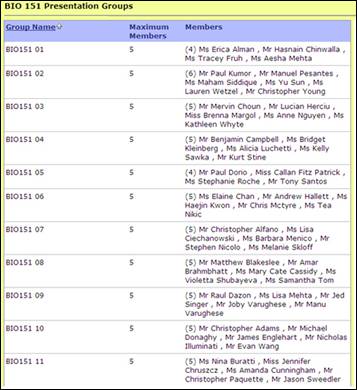
Figure 2. Signup Sheet
Discussion groups were also set up in Blackboard
VISTA™ and linked to each presentation group. This
linkage provided an electronic “meeting place” for
each group to plan their presentation if needed
(Figure 3).
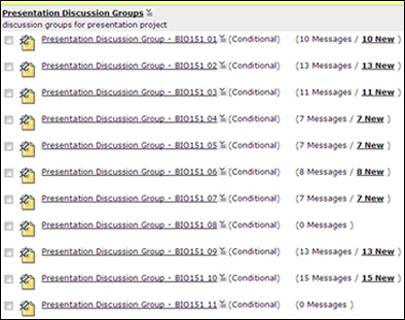
Figure 3. Discussion Groups
Each presentation group was assigned the task of
developing 10-15 PowerPoint slides about a concept
germane to the lecture material for the week chosen
for their presentation. Four groups presented per
week in the ten week term. The instructor delivered
a lecture during the first lecture period each week
(Tues.) on the basic concepts presented in the
assigned textbook chapter for that week. Student
groups gave their presentations during the second
lecture period each week (Thurs.) Group
presentations were recorded using a video camera.
PowerPoint™ slides from each presentation as well as
the video clip were posted to the course website
each week and were available to students during
their exam periods (Figure 4).
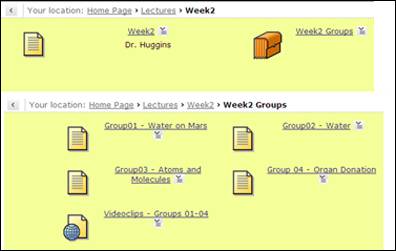
Figure 4. Instructor/Student Weekly Lecture Slides
and Videoclips
Twenty-five points were awarded for each
presentation according to the following rubric: 1) 5
points for making the presentation; 2) 5 points for
good organization of concepts (e.g. introduction to
the issue, development of information, emphasis
provided by multimedia, basic conclusions); 3) 5
points for incorporation of a germane multimedia
feature; 4) 5 points for providing the instructor
with an electronic copy of the presentation; and 5)
5 points for developing an exam question from the
presentation. An extra five (5) points were added to
scores for individuals in the first eight (8) groups
giving a presentation. The extra points served as
an incentive for student participation during the
early weeks of the term.
Laboratory
Typically, students were enrolled in 1 of 10 to12
individual lab sections of approximately 20 students
each. The lab sections were “cross-listed” in the
Blackboard VISTA™ course module to enhance
efficiency with regard to uploading of laboratory
instruction materials as well as
administration/grading of weekly quizzes.
“Cross-listing” is a term which is synonymous with
compiling all the lab sections together on one site
so that lab instructions and other materials only
have to be uploaded to the site once. Each lab
section was given a unique identifier so that the
entire “cross-list” could be searched and sorted for
results by lab section if needed (Figure 5).
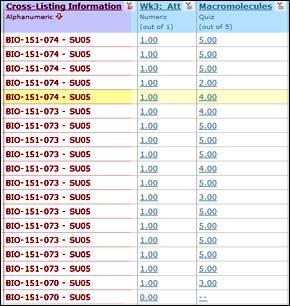
Figure 5. Cross-Listing of Lab Sections
Laboratory scores were based on weekly quizzes
emphasizing the basic principles behind the
laboratory exercise(s) and student attendance.
Weekly quizzes were automatically and selectively
released to each individual lab section of students
with deadlines for completion specific to each
section (Figure 6).
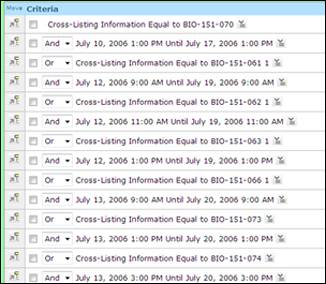
Figure 6. Selective Release of Lab Quizzes to
Multiple Sections
Scores for weekly quizzes were made immediately
available to students upon completion of the
quizzes. Correct answers for the quizzes were
usually available one week following the quiz due
date. Student lab attendance was manually entered
(by TAs) into the grade book as a “1” for attendance
or “0” for non-attendance. At the end of the term,
this attendance column was multiplied by the weekly
quiz score. Hence, students who may have taken the
automated quiz, but did not actually attend the
weekly lab, scored no points for the quiz (i.e. 0
(attendance) x 5 (quiz score) = 0). In this manner,
attendance was linked to quiz score (Figure 7).
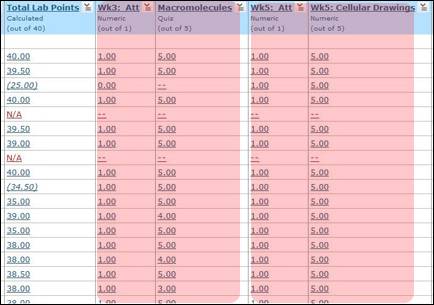
Figure 7. GradeBook, Laboratory Quiz Columns
The final score for the lab was tabulated by adding
the number of points achieved on each lab quiz
(multiplied by attendance). The tabulation was
automatically calculated by Blackboard VISTA™
(Figure 8).

Figure 8. Laboratory Total Score Calculation
The calculated total lab score was subsequently
integrated into the calculations determining the
final grade for the course (midterm + final +
presentation + lab total score) which was also
automatically calculated by Blackboard VISTA™.
Results
Exams
The percentage of students in BIO 151 completing
their exams by the due date was 93% and 92% for
midterm and final exams, respectively. Very few, if
any, technical problems were reported, due in part,
perhaps, to an exam tutorial placed on the homepage.
The tutorial included a short video clip explaining
the exam procedure and a small, demonstration exam
in Blackboard VISTA™. The average score
on the midterm exam was 23.5/25 points (max: 25;
min: 19). The average score on the final exam was
22.4/25 points (max: 25; min: 17).
Presentation Project
Thirty-four (34) groups of 5-6 students gave
presentations during the term on topics found in
textbook chapters, two through ten (2-10). Title
slides from 19 of these presentations can be viewed
by following this link:
BIO 151 Presentations
Laboratory
The percentage of students in BIO 151 completing
their laboratory activities was 93%. The average
total score for laboratory activities was 21.1/25
(max: 25; min: 3).
Final Grades
Approximately 25% of the students in this course
made an A+; 50%, an A. Grades of B or lower were
distributed as indicated below:
·
A+ (97% and above) -- 27.8%
·
A (90-96%) -- 52.7%
·
B (80-89%) --13.3%
·
C (70-79%) -- 2.4%
·
D (60-69%) -- 0.6%
·
F (less than 60%) -- 2.4%
Discussion
Historically, BIO 151: Applied Biology has been
considered a difficult course to teach. For
students, it has been an unwanted, but necessary
course for which to register in order to graduate.
Classes (and laboratories) have often been plagued
by low attendance. Poor performance and steadfast
lack of interest on the part of student and
instructor were characteristic of this course.
Unfortunately, a large communication gap was also in
evidence primarily because neither party cared a
great deal about what the other party had to say.
This case study attempted to remedy at least some of
these ills by offering students a chance to engage
more personally (fully) with the concepts being
taught; to assume, as it were, the role of “lecturer
for a day”. Moreover, accurate, efficient record
keeping of scores was provided which enhanced the
integrity of the course and elevated the level of
student trust in the course, the instructors, and
the teaching assistants.
Exams
The goal of the exams given in BIO 151 was to
provide an opportunity for students to review the
material presented (both by them and by the
instructor) and to touch base, once again, with the
basic concepts and issues addressed during the
term. Needless to say, rote memorization of fact
was not needed (or expected) in order to pass these
exams. Rather, students could access exam materials
easily through Blackboard VISTA™, review them, and
select (hopefully) the best answer(s) for the
questions posed. Moreover, Incorporation of
questions from student presentation materials on
exams broadened the exam experience for many in that
not all the correct answers could be found in the
textbook, but rather in the slides, video clips, and
URLs of student presentations. The high incidence
of good scores on these exams indicates that
students were successful in reviewing and
understanding the basic concepts presented. Due
to the fact that exams were in open-book format and
available to students for a period of about 3 days
over the exam weekend, there really was no method by
which to monitor students during exam-taking.
Hence, student collusion on the exams could have
occurred. However, student collaboration was
encouraged for exam-taking as a part of the emphasis
on group interaction in this class. Moreover, it
was felt that this type of encouragement tends to
mitigate, to a certain extent, dishonest intention
with regard to taking exams. The need to “cheat” is
removed, essentially; collaborative interaction is
supported, and many students benefit from a group
experience in which potential answers to the exams
are researched. So, while some collusion may have
occurred; true collaboration did as well.
Presentation Project
The presentation project allowed space for student
creativity, not only with regard to selection of
topic, but also in reference to graphic design and
incorporation of multimedia resources. For example,
although “You-Tube” video clips are not always
considered of highest quality in terms of production
conditions, their incorporation into some of these
presentations required review and analysis of the
clip by students and considerations with regard to
appropriateness. Many of the clips presented
(whether from You-Tube or other sources) reflected
careful consideration by students as to how the clip
could enhance the presentation. For example, the
presentation about “Water on Mars” incorporated a
video clip of NASA’s Mars Rover and its search for
water on Mars. The presentation about “Organ
Donation” included a video clip from the movie,
“John Q” which depicts a father’s frantic search for
an organ for his dying son. An excellent video clip
about anorexia was included as part of the
presentation about “Eating Disorders”. Overall,
this particular aspect of the course provided a good
outlet for student creativity and engaged them very
effectively with the subject matter.
Laboratory
Many students from non-science backgrounds are
daunted by a “hands-on” laboratory experience. In
view of this reticence to embrace laboratory
experiments wholeheartedly, the laboratory
activities for these students included well-planned
(and explained) experiments with historically, a
very small chance of failure. An attempt was also
made to balance their exposure to activities in
which a reasonable level of technical expertise was
required with activities which relied more fully on
audio-visual materials. Moreover, incorporation of
simple quizzes on the basic principles behind each
laboratory activity served to reinforce those
principles. In short, laboratory activities for
non-major students do not have to be difficult to
engage them. Rather, simple, straightforward
expressions of basic concepts are probably more
effective. As with the major exams given in this
course, the percentage of high scores on lab
quizzes/exercises indicates a good grasp by students
of the principles presented in laboratory
activities.
The decision to give lab quizzes on basic concepts
versus requiring a formal laboratory report on each
exercise was based on several factors. The first
factor was the large enrollment for this course
making individual grading of lab reports an arduous,
time-consuming weekly process. Secondly, the
subjectivity and lack of consistency exhibited by
TAs (and instructors) with regard to manually
grading lab reports is well-known and would be
possibly compounded by the large numbers of reports
in this instance. Finally, the instructor felt that
very few if any non-major students would be required
to write formal lab reports in their chosen
jobs/careers upon graduation
Conclusions
One of the major conclusions from this case study is
that student creativity should not be underestimated
simply because the course is a non-majors course.
Creativity may lie dormant in many non-major courses
because it isn’t tapped by the traditional teaching
formats often used in these courses. (This could
also be said of traditional teaching formats in
major courses!). Giving creative voice to students,
even in courses which are not in their major area,
provides both students and instructor ample “play”
space in which to explore any/all concepts under
study. Incorporating multimedia elements into this
“play” space also serves to enrich the
learning/teaching experience.
While it is true that not all students (or
instructors) will take advantage of this type of
opportunity, encouraging student participation in
the development of lectures/materials for the course
establishes a direct conduit to the concepts being
taught. The student views presented are often
refreshing and reflect their unique perspectives on
the issues underlying the material. The particular
requirement that students work in groups stimulates
interaction between students which also enhances
their appreciation of alternative viewpoints.
This case study also underscores the fact that
effective, automated record keeping is its own
reward in large courses in which student performance
on a large number of different activities has to be
recorded accurately. In this particular course, 167
students completed 2 major exams, a presentation
project, and at least 5-8 laboratory activities.
Each individual’s laboratory attendance was also
monitored for 10 weeks. Hence, a total of
approximately 3000 data points were used to obtain
final grades. Utilization of Blackboard VISTA™ to
automate quiz/exam delivery/grading, and compile
attendance as well as presentation project scores
was extremely helpful and emphasizes the fact that
large numbers of students are “doable” in terms of
record keeping if you automate it. Moreover, the
course motto of “everything in the grade book”
encouraged students to check the grade book for
their scores on all activities and to contact either
instructor or TA if they felt something was amiss.
This “transparency” gave them a sense of ownership
and prompted stewardship with regard to their scores
and, eventually, their final grade.
Acknowledgements
The authors would like to thank the staff of the
Online Learning Team at Drexel University for their
patience and technical assistance in the development
and maintenance of BIO 151: Applied Biology. The
Instructional Media Services Group at Drexel
University is acknowledged for lending their video
cameras (with instructions) to this project. The
teaching assistants (TAs) and students of BIO 151
are also to be commended for consenting to “play” in
this creative partnership endeavor.
References
Belk, C. and Borden, V. (2007) Biology – Science
for Life (With Physiology), 2nd
Edition, Benjamin Cummings.
ITUE (Institute for Transforming Undergraduate
Education) (1996). Catalysts for Change:
Foundation Courses and Instructional Innovation.
Statement of the Problem. National Science
Foundation proposal.
Weiman, C. (2007). A New Model for
Post-Secondary Education, An Optimized University.
Carl Weiman Science Education Initiative (CWSEI).
University of British Columbia.
http://www.cwsei.ubc.ca/resources/files/BC_Campus2020_Wieman_think_piece.pdf
Wood, W. (2004). Changing the Way We Teach
Science, Conference Proceedings, Nov. 18-19,
Integrating Research into
Undergraduate Education: The Value Added.
National Science Foundation and Woodrow Wilson
National Fellowship Foundation.
|








